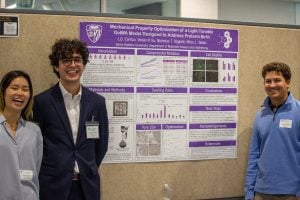
One in 10 children in the United States is born prematurely, putting them at risk for a host of health challenges that range from chronic asthma and loss of hearing to sepsis and sudden infant death syndrome. For his senior design project, the capstone, experience of his undergraduate education, materials science student Juan Diego Carrizo decided to address one of the primary causes of premature birth: premature softening of the cervix.
“In a healthy pregnancy, you want the cervix to be soft at the time of birth, around the 40-week mark, so the baby can pass through the birth canal. Before that point, though, the cervix needs to be stiff so that maturation will occur in the uterus,” Carrizo explains. If there was a way to predict whether or not a cervix was likely to soften prematurely, steps could be taken, therapeutics developed, that potentially could prolong a pregnancy and save lives, and this the challenge that Carrizo set out to solve.
In order to better understand the mechanics of the cervix and the changes it undergoes during pregnancy, Carrizo decided to build a 3D model of the human cervix that could act as a “sandbox” for living cells from the human female reproductive tract and provide future researchers the opportunity to explore cervical cell behavior. To make it accurate, he had to devise a way to make artificial tissue that could stiffen and soften, as human tissue does, during the different stages of pregnancy.
Carrizo built his model out of light-tunable hydrogel, a substance that changes in stiffness based on when and for how long it is exposed to UV light through a process called photo-crosslinking. “The light activates molecules that will cause the material to gel. In other words, the chemical building blocks assemble together and form the gel when the light is there. In general, the more intense the light exposure, the stiffer the gel will be.” Carrizo and his team then measured other observable properties, like “pore sizes and how much it swelled when you put it in water,” an important factor because the level of hydration in cervical tissue increases significantly during pregnancy, but also, the model had to retain its properties for the purpose of growing the reproductive tract cells, called fibroblasts, which requires the model to be submerged in nutrient solution. “We wanted to make sure that cells are able to infiltrate the model and move around and attach,” Carrizo explains. “Finally, we seeded the cells, and we were able to prove that they were happy and alive for up to a week, which was a really good sign. The next step for the project is adding other types of cells also present in the cervix into the construct to further mimic the tissue of the cervix at those different stages and then studying the model at different stages to understand early remodeling of the cervix and see how the cells respond.”
What Carrizo is looking for is if cells send out signals saying there is too much of a specific molecule or any other biological warning signs that a cervix is softer than it should be at a given stage. He believes the model itself could in the long run also be used to test potential therapeutics that could signal tissue to hold off on the softening process. “There are therapeutics in place to prevent premature births when detected but most of them are very invasive and painful, more a Band-Aid than a fix,” Carrizo explains. Indeed, one of the common practices involves a set of stitches in the cervix to just hold it in place.
Carrizo says that through his research, he saw a gap in the system that needed addressing: the underrepresentation of maternal health studies in drug development. Mitra Taheri’s lab has been researching preterm birth since 2016. “They were very supportive,” Carrizo says. “So, we had all the pieces and all the motivations and all the funding to pursue this and see where we could go with it.”